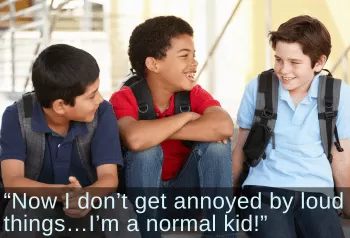Primitive Reflex Integration Case Studies
11-Year-Old Boy with Sensory and Emotional Challenges is Transformed by Neurodevelopmental and Integrative Movements
Rhythmic movements and primitive reflex integration help pre-teen with sensory and social issues.
Classroom sounds and activity were overwhelming to this boy, who would rarely interact with his fellow students, always wear his hooded winter coat indoors, and often hide under a table. By his fourth session practicing rhythmic movements and primitive reflex integration—a process he enjoyed and found calming—he is no longer wearing his winter coat, and he's beginning to interact with his classmates.
Submitted by S.L., Occupational Therapist

| Before | After |
|---|---|
| Always wore a winter coat with the hood up indoors | No longer wears his winter jacket in class |
| Kept to himself, often crying and hiding under a table | Engages more in classroom discussions and is beginning to interact (even joke) with peers |
| Struggled with anxiety, transitions, and new situations | Teachers describe him as a completely different student |
Luke is an 11-year-old individual with Autism, referred to Occupational Therapy with concerns around emotional and sensory regulation. The team reported that he generally kept to himself, often crying and hiding under a table. They reported that Luke struggled with anxiety, transitions, and new situations. When his teacher introduced us, I immediately noticed he was wearing his winter jacket with his hood over his head. He agreed to meet with me later that week.
When he came to my room, Luke was wearing his jacket with his hood up. I could see that he had tears on his cheeks and was not ready to participate on this particular day. So, I invited him to just observe as another student performed…movements from Brain and Sensory Foundations First Level, (Part 1). Before he left that day, he agreed to meet me the following week.
That next week, I introduced Luke to the Brain Tune-up and Innate Rhythmic Movements. This time, he was ready to engage, trying each exercise. He struggled at first [but reported that some of the rhythmic movements] were very relaxing. I wanted to focus on building a foundation and trust; so, I began with the 4 Innate Rhythmic Movements. I also knew that Rhythmic Movement #1 would help to integrate the Tonic Labyrinthine Reflex, a stepping stone for integrating the Fear Paralysis Reflex (anxiety & shyness) and Moro Reflex (hypersensitivity), which all four Rhythmic Movements would support as well.
Two weeks later, we met again. Jacket still on, he reported that he was performing some of the exercises at home and noting positive changes. Once again, he reported that he enjoyed Rhythmic Movement #2.
During our next session, I introduced the 5-Step Balance from Brain and Sensory Foundations First Level, (Part 1). Luke identified that his goal was to feel relaxed. He acted out the action in sitting by closing his eyes and trying to note what it was like to actually feel calm. Then we stimulated the Tonic Labyrinthine Reflex in standing and began our Rhythmic Movement exercises, along with Superman, which we modified into Swimmer’s Pose—arms only. We completed the Support Repatterning Sequence in standing followed by acting out his goal a second time. This time, he closed his eyes and smiled. Opening them, he replied, these exercises make me feel great!
Today, following April vacation, we met for our fourth session. Luke was not wearing his winter jacket. Instead, he was wearing a hooded sweatshirt with the hood down! He reported, “I’m more comfortable. Now I don’t get annoyed by loud things.”
Continuing to focus on sensory processing, I introduced the [integration for] the Fear Paralysis Reflex…Moro Reflex and Spinal Gallant Reflex…Luke loved these integration activities and was actually laughing out loud. “I’m a normal kid,” he replied.
His teachers have reported that he appears to be a completely different student! Luke no longer wears a hood, engages more in classroom discussions, and is beginning to interact (even joke) with peers. I am truly amazed at his quick transformation! This experience has definitely shown me how extremely important and effective Innate Rhythmic Movements are for all of us. I look forward to even further developments for Luke with additional reflex integration activities.
[Edited for length and clarity, emphasis added]
*Disclaimer: The activities in the Brain and Sensory Foundations curriculum make use of the natural processes of neuroplasticity and development that are innately wired in the design of human beings to promote maturity and function. These activities appear to calm, organize, and mature the neuro-sensory-motor systems just as we see in the healthy development of human infants. Individual results may vary, and we do not claim to offer a diagnosis or cure for any specific condition or disorder. The Brain and Sensory Foundations activities appear to improve overall functioning resulting in measurable improvements for a range of conditions as demonstrated in over 1800 case studies from participants.

